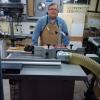Wow, this one really got a lot of traction  . They taught us metric and threatened full conversion a couple of times in school, even changed all the speed limit signs out here once in a typical great use of tax dollars. I can use either but, prefer imperial. Certainly this is partially due to being primarily raised on it.
. They taught us metric and threatened full conversion a couple of times in school, even changed all the speed limit signs out here once in a typical great use of tax dollars. I can use either but, prefer imperial. Certainly this is partially due to being primarily raised on it.
The result of a few false starts during my lifetime is that I am comfortable estimating volumes and short distances in either. My estimation of metric speed is pretty useless but, 'about' 25 mm to the inch works visually and we all know 'about' the length of a 100 mm cigarette. My 35 years of octal, decimal and hex at work has done something to my brain. I find it almost like a serotonin spike when thinking in imperial. Thinking in fractions soothes my mind when I am in the shop. It is certainly nothing to go all Ford/Chevy or Tastes-Great/Less-Filling over  .
.
"A hen is only an egg's way of making another egg".
– Samuel Butler









 . They taught us metric and threatened full conversion a couple of times in school, even changed all the speed limit signs out here once in a typical great use of tax dollars. I can use either but, prefer imperial. Certainly this is partially due to being primarily raised on it.
. They taught us metric and threatened full conversion a couple of times in school, even changed all the speed limit signs out here once in a typical great use of tax dollars. I can use either but, prefer imperial. Certainly this is partially due to being primarily raised on it. 
 I do everything in my shop in biquinary.
I do everything in my shop in biquinary. (go ahead, find such a Stanley tape ...I dare ya.
(go ahead, find such a Stanley tape ...I dare ya. )
) 


